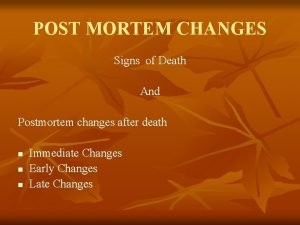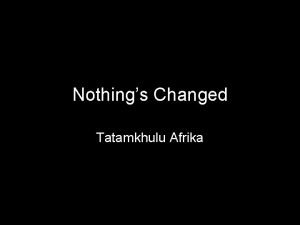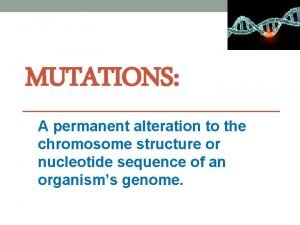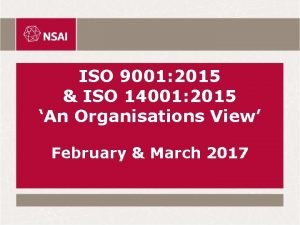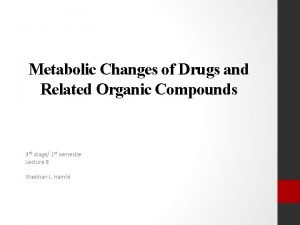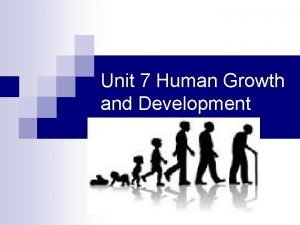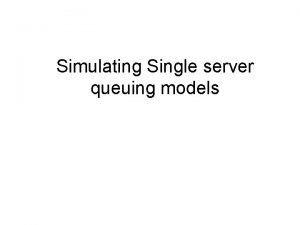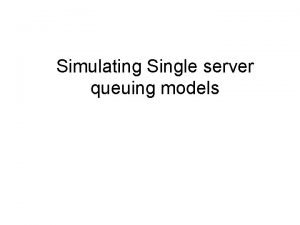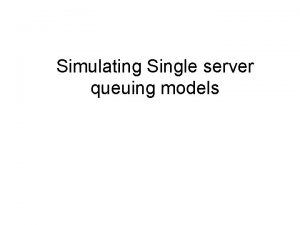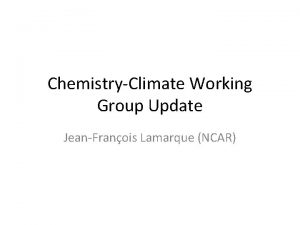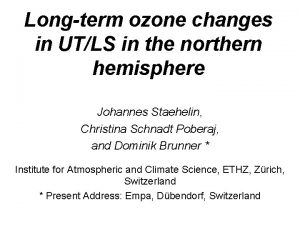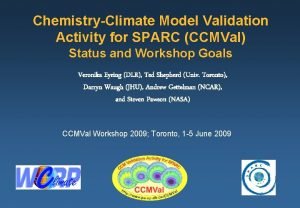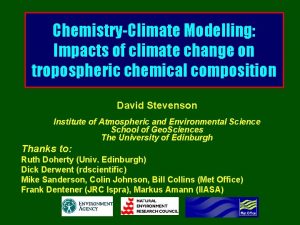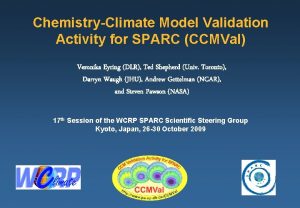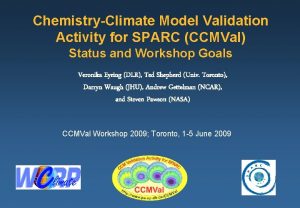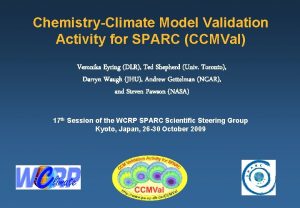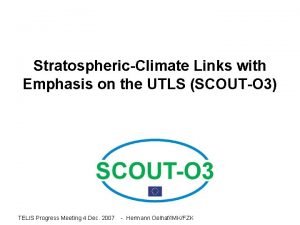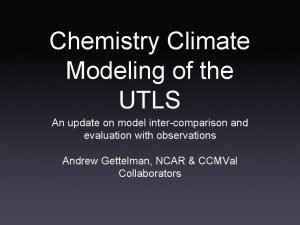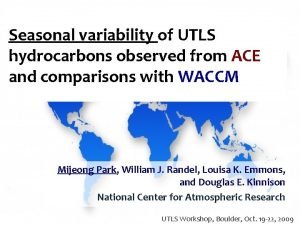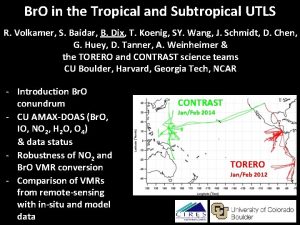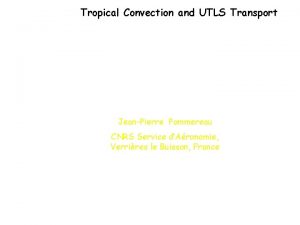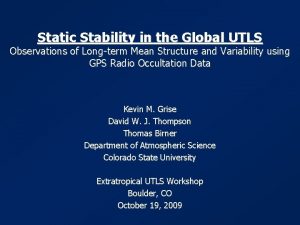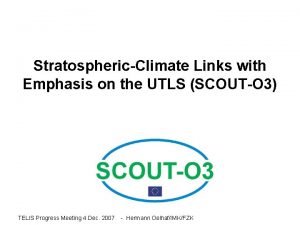Simulating UTLS changes in chemistryclimate models Andrew Gettelman





















- Slides: 21

Simulating UTLS changes in chemistry-climate models Andrew Gettelman, NCAR + CCMVal-2 Model PIs

CCMVal Model PI’s CCMVal = Chemistry Climate Model Validation project MODEL NAME AMTRAC 3 CAM 3. 5 CCSRNIES CMAM CNRM-ACM Teyssedre E 39 CA EMAC MPI GEOSCCM LMDZrepro MRI NIWA-SOCOL ULAQ UMETRAC UMSLIMCAT UMUKCA-METO UMUKCA-UCAM WACCM (v. 3) INSTITUTION GFDL, USA NCAR, USA NIES, Tokyo, Japan MSC, U. Toronto, York U. , Canada Meteo-France, France PRINCIPAL INVESTIGATORS John Austin Jean-Francois Lamarque Hideharu Akiyoshi David Plummer, John Scinocca, Ted Shepherd Martine Michou, Francoise Cheroux, Hubert DLR, Germany Mainz, Germany NASA/GSFC, USA IPSL, France MRI, Japan NIWA, NZ PMOD/WRC and ETHZ, Switzerland University of L'Aquila, Italy NIWA, NZ University of Leeds, UK Met. Office, UK University of Cambridge, UK NCAR, USA Martin Dameris, Hella Garny Andreas Baumgaertner, Christoph Brühl, Patrick Jückel Steven Pawson, Rich Stolarski, Stacey Frith Slimane Bekki Kiyotaka Shibata Dan Smale Eugene Rozanov, Tom Peter Eva Mancini, Gianni Pitari Olaf Morgenstern Martyn Chipperfield, Sandip Dhomse Neal Butchart, Steven Hardiman Peter Braesicke, Olaf Morgenstern, John Pyle Rolando Garcia, Andrew Gettelman, Doug Kinnison

Tropical Circulations ‘appear’ to be Changing Seidel et al, Nature Geoscience 2008

Implications • Profound effects on UTLS • Impacts on Precipitation, Regional Climate • Is the UTLS diagnostic or does it affect the response? (is there a feedback in the UTLS)

Theories/Mechanisms • Jets strengthen due to radiative forcing – Thermal Wind Balance in UTLS (e. g. : 200 h. Pa) – Ozone depletion makes hemispheres asymmetric • Stronger jets alter stability & wave propagation – Changes baroclinic instability Frierson et al 2007, Held & Hou 1980, Held 2000 – Increase in Phase speed pole-ward breaking displacement (Chen & Held 2007) • Surface forcing (mean temp or ∂T/∂y) • Due to changes in mean T mostly; similar effect • Also changes baroclinic instability • Note: change in static stability (Δθ) caused by moisture too, not just ΔT • Differences: Local (UTLS) or Tropical Forcing?

Simulation Results from CCMVal-2 • Models in support of WMO-2010 • Partial results from 17 models, 4 re-analyses • REF-B 1: 1960 -2005 Historical Runs – Observed SST, GHG, Halogens, Volcanoes • REF-B 2: 1960 -2100 – IPCC A 1 B GHGs beyond 2005, WMO Halogens – Simulated (CMIP GCM) SSTs, or Coupled Ocean • This work: Preliminary Results – Can we see these features? – Mechanisms?

Diagnostic Description Diagnostics: X X 1. Tropopause Pressure trends 2. Width between LRT 3. Jet Speed 4. Width between Jets 5. Meridional Streamfunction 6. OLR 7. Precipitation

Tropopause Pressure Annual Zonal Mean Trend (h. Pa/yr)

Correlation with Observations Trends in Subtropics are significant SH Larger Trends (1 -2 odecade-1) than NH Variability Dominated by Volcanic effects

�Tropopause Width at 200 h. Pa Full Field • Width Generally Increasing • Not statistically significant – large variability • Anomalies not strongly correlated – Re-analysis anomalies also Anomalies • Note Drop after 2000 – Trends not monotonic?

Jet Maximum Speed at 200 h. Pa Simulated Anomalies correlated with analyses ANOMALIES FULL SPEED SH NH

Jet Width at 200 h. Pa Full Field • Mixed trends, not significant – Dominated by variability (ENSO) • Simulated variability correlated with Re-analyses • Note: Anomalies – Coarse resolution (on model grid) – not interpolated – No Smoothing

Summary: 1960 -2005 • Coarse resolution (200 -500 km) limiting – Easier for ‘interpolated’ diagnostics • Changes often are less than variability – Trends often not significant – Differ between Re-analyses • Can see the forcing (ENSO, Volcanoes) in Variability • Simulated variability correlated with Re-analyses – Inter-annual variations (also looking at seasonal) – Diagnostics: Jet Speed & Width, Tropopause Pressure – Tropopause width not as well correlated

Future Scenarios • Extra-tropical (Polar) Tropopause Height – Discussed by Michaela on Monday S. Hemisphere Trends in SH are visibly not monotonic N. Hemisphere

Effects of O 3 Depletion on Trends • SH Tropopause Trends are affected by O 3 depletion • Trends largest with O 3 depletion (1960 -2000) • Lower trends with O 3 recovery (2000 -2050) • Climate change (GHGs) during all periods • N. Hemisphere trends more monotonic • Overall trend is similar between hemispheres 1960 -2000 2051 -2099 2001 -2050

Tropopause Width Changes at 200 h. Pa • Overall trends fairly consistent across models: +0. 5 o decade-1

Jet Max Speed increases at 200 h. Pa N. Hemisphere S. Hemisphere • Jet Maximum Speed increases in both hemispheres • Differences in simulated trends (0. 2 -0. 3 m s-1 decade-1) • Not clear if SH trends are monotonic (need to do some further statistical analysis)

Conclusions (so far) • Models ‘consistent’ with assimilated systems – Variability is good (necessary but not sufficient) – If mechanisms are resolved scale waves & get variability, then perhaps get trends • Future trends in tropopause height affected by O 3 – Does this translate into changes in circulation/climate? • Jet speed increases in future, tropopause widens – Quantitatively consistent with other work – Meridional Streamfunction zero latitude moves poleward – Broadly matches theories Next Steps: – Precipitation changes? – Pick apart effects in simplified models: Role of UTLS

O 3 Prediction in LMS |40 -60| Lat, 200 -100 h. Pa S. Hemisphere N. Hemisphere SH: O 3 loss, recovery, ‘super recovery’ NH: ‘Flat’ in 20 th Century, 20% increase in 21 st Century Note: Upper (150 -100 h. Pa) & Lower (250 -150) LMS similar Also: Historical runs and comparison to NIWA-O 3 data set

Ozone Trends (%) 1960 -2100 CCMVal Model Ensemble (Credit: Birner)

Plug: Community Diagnostics • Plots built with a CCMVal-diagnostic package • Easy to do complex analysis with models – O 3 plots done this morning • Bring observations to models • Interested? Talk to me.
 Late post mortem changes
Late post mortem changes Diaphanous test
Diaphanous test What is physical change and chemical change
What is physical change and chemical change Elizabeth mulroney
Elizabeth mulroney Difference between modals and semi modals
Difference between modals and semi modals What economic changes in the 1830s promoted german unity?
What economic changes in the 1830s promoted german unity? Middle adulthood social changes
Middle adulthood social changes Directional selection
Directional selection What caused the beverly hills supper club fire
What caused the beverly hills supper club fire 5 general types of chemical reactions
5 general types of chemical reactions Physical and chemical changes jeopardy
Physical and chemical changes jeopardy Indirect speech of interrogative sentences
Indirect speech of interrogative sentences When was nothing's changed written
When was nothing's changed written Permanent alteration
Permanent alteration Family of orientation
Family of orientation Iso 9001;2015
Iso 9001;2015 Metabolic changes of drugs and related organic compounds
Metabolic changes of drugs and related organic compounds Isrs 4400 revised
Isrs 4400 revised Sources of social change
Sources of social change Lesson 6 changes of state answer key
Lesson 6 changes of state answer key Physical changes in everyday life
Physical changes in everyday life Forms of development
Forms of development

